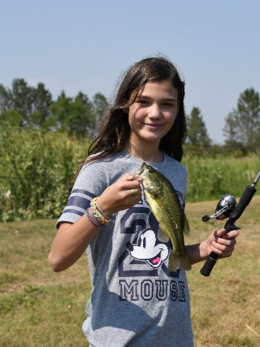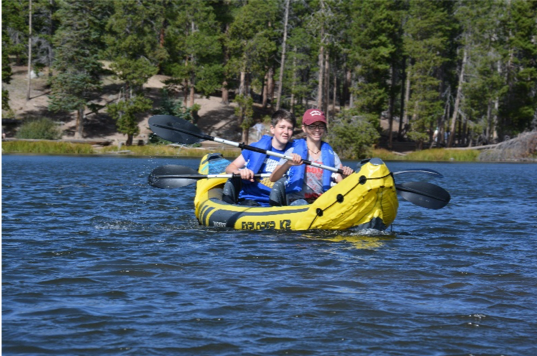Research shows that outdoor education leads to positive impacts on school performance, student health, and the community. I have worked in California, Minnesota, and Colorado and have been able to realize the benefits for both students and staff in creating and growing an outdoor education experience at Christian schools. Regardless of where you live, you can start an outdoor education program at your school. First, you need to determine what outdoor opportunities exist in and near your community. Next, research the resources available to you in and around your community. Finally, the most important factor is having a teacher (or teachers) who is passionate and can take the lead.
Getting Started—From Scratch

At New Life Academy in Woodbury, Minnesota, we were facing a schedule dilemma that was born out of switching focus from quarters to semesters for electives in the middle school. We were offering a First Aid course that was set up for a quarter, but did not have enough curriculum to cover a semester course. We began brainstorming, and our conversations about first aid bridged into thinking about life skills and then survival skills—and then my Eagle Scout experiences kicked in and we began trading ideas about outdoor skills such as camping, fishing, rock climbing, and snowshoeing. We began thinking about the concept of an outdoor education course to be built around the existing first aid course, and we were keenly aware that we were on the right track. Taking our students outside would not only have benefits for their learning and overall health, but in today’s high-tech world of screens and gadgets, would give them much-needed opportunities to explore and appreciate God’s marvelous creation.
Although I was the elementary principal, I was passionate about this idea and wanted to be involved at the ground level, so I met with Mike Moberg, our sixth-grade teacher, and started to plan out what we wanted to do. We literally started the class with 14 students and had camping and fishing loosely planned, but we were building the class as we taught it. I began over the summer by researching resources for lessons, and found the book Quality Lesson Plans for Outdoor Education and started building units that we could do with our outdoor education students. Being the avid Minnesota fisherman, Mike started with a fishing unit and I began developing a camping unit that taught students how to find a good, functional camp site; build and maintain a campfire; use a knife, ax, and saw safely; tie basic knots; set up and tear down a tent; and prepare and cook meals outdoors.
Taking it Outdoors
As the semester began, we looked into regional and state parks where we could bring this new class to fish and to camp overnight. Once on site, we taught the students that many hands make lighter work, and dispersed duties such as meal prep and clean up. We had students making spaghetti and meatballs, Caesar salad, and garlic bread for dinner. We made “gourmet s’mores” with peanut butter cups, peppermint patties, and other non-traditional candy bars. We had students washing dishes and coming up with night games under the stars.
When they rose early the next morning on the north shore of Lake Superior to a balmy 25 degrees, the students quickly learned the benefits of a good campfire! They learned how to make scrambled eggs, blueberry pancakes, and of course, bacon. We proceeded to take them on a five-mile hike along the shore and upwards from there exploring the trails of Gooseberry Falls State Park. After returning to the campsite to tear down the tents and equipment, we headed back to Woodbury after a stop at world-renown Betty’s Pies to enjoy some local treats. This became a tradition with every trip, enjoying a local attraction that most (if not all) students had never  experienced before.
experienced before.
The semester went on with the development of a rock-climbing unit including three visits to Vertical Endeavors in St. Paul, as well as orienteering with a local orienteering expert via http://iknowmyway.org/ where students learned how to set a pace, read a map, collaborate with a team to locate flag stations in a local park. We found snowshoe trails within walking distance from the school, which became mountain biking trails in other parts of the year.
As I made the transition from Minnesota to Colorado, I was able to work with a pair of teachers who were passionate for outdoor education. They had some parts of a program in place. But within the first year we added fishing, trap shooting, rock climbing, archery, and camping. Our proximity to the mountains created a natural opportunity, but no matter your location, you may be able to pursue activities such as: camping; fishing; archery; kayaking/canoeing; shooting; road biking or mountain biking; orienteering; hiking; cross-country skiing; snowshoeing; rock climbing; and addressing environmental issues.
Overcoming Obstacles
 Initial obstacles were the lack of equipment and funding. I began looking at resources for where we could get support in the form of equipment. Our local REI had a gear bank program where we were able to borrow, without cost, four-man tents, sleeping bags, sleeping pads and propane stoves. Eureka! I was also able to acquire funding from our business director in order to get the program off the ground. Several donors also contributed with the initial purchases of equipment. We eventually made the class fee-based in order for it to be self-funding, and thus were able to purchase the equipment we needed over time.
Initial obstacles were the lack of equipment and funding. I began looking at resources for where we could get support in the form of equipment. Our local REI had a gear bank program where we were able to borrow, without cost, four-man tents, sleeping bags, sleeping pads and propane stoves. Eureka! I was also able to acquire funding from our business director in order to get the program off the ground. Several donors also contributed with the initial purchases of equipment. We eventually made the class fee-based in order for it to be self-funding, and thus were able to purchase the equipment we needed over time.
Parent concerns were minimal, but were addressed as they came up. We were very specific in providing safety for the students as they learned to work with knives, axes, saws, fire, mountain bikes, snowshoes, rock-climbing gear, fishing poles, and even air rifles. Clear instructions and demonstration of safe learning was paramount to our success with the class. Liability and insurance were not huge obstacles, but we did have to clear some activities with our insurance company and risk manager, and use waivers for rock climbing from the business we were utilizing.
Student Outcomes
 Definitive outcomes of an outdoor education program include better grades, better health, decreased stress levels, increased motivation, better attitudes about the environment, better overall behavior, enhanced communication skills, and increased self-reliance.
Definitive outcomes of an outdoor education program include better grades, better health, decreased stress levels, increased motivation, better attitudes about the environment, better overall behavior, enhanced communication skills, and increased self-reliance.
In both schools where I have worked on creating an outdoor education program, I have seen a marked improvement in these areas in the students who participated in our program. Student outcomes include a stronger sense of community through shared experiences, a new interest in archery that has caused us to establish a competitive archery team, and increased confidence, creativity, and problem-solving skills. And students developed deeper relationships and appreciation of their peers, their teachers, and their Creator.
The best classroom is outside. Get out there!
About the Author
 Brian Goodbar is a middle school principal in Loveland, Colorado. A California native, he has also lived in Minnesota and Colorado. He has worked in public and private Christian education for 25 years. Married for 30 years (this year!) with two adult children, he enjoys the great outdoors, hiking, biking, and photography. A gifted guitar player, he has been a part of worship bands, pit bands, and orchestras in schools and churches for over 30 years. He can be reached via email at bgoodbar@rcschool.org.
Brian Goodbar is a middle school principal in Loveland, Colorado. A California native, he has also lived in Minnesota and Colorado. He has worked in public and private Christian education for 25 years. Married for 30 years (this year!) with two adult children, he enjoys the great outdoors, hiking, biking, and photography. A gifted guitar player, he has been a part of worship bands, pit bands, and orchestras in schools and churches for over 30 years. He can be reached via email at bgoodbar@rcschool.org.
Note: Originally posted March of 2019 and republished March 2022.

